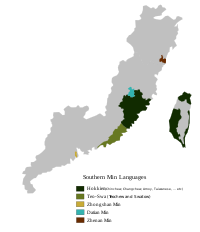Hui'an dialect
| Hui'an dialect | |
|---|---|
| 惠安话 / 惠安話 | |
| Native to | China |
| Region | Mainly in Hui'an and parts of Quangang District (formerly part of Hui'an), South Fujian province. |
Sino-Tibetan
| |
| Language codes | |
| ISO 639-3 | – |
| Glottolog | None |
| Linguasphere | 79-AAA-jda |
The Hui'an dialect (simplified Chinese: 惠安话; traditional Chinese: 惠安話; Pe̍h-ōe-jī: Hūi-oaⁿ-ōe), is a variety of Chinese mostly spoken in Hui'an in South Fujian Province, China. It belongs to the Hokkien subgroup of Southern Min.[1]
Phonology[]
The Hui'an dialect has 14 phonemic initials and over 80 finals.[2][3]
Consonants[]
| bilabial | alveolar | velar | glottal | ||
|---|---|---|---|---|---|
| plosive | voiced | /b/ 马 / 馬 |
/ɡ/ 鹅 / 鵝 |
||
| voiceless unaspirated | /p/ 布 |
/t/ 大 |
/k/ 歌 |
/ʔ/ 乌 / 烏 | |
| voiceless aspirated | /pʰ/ 坡 |
/tʰ/ 兔 |
/kʰ/ 去 |
||
| affricate | voiceless unaspirated | /ts/ 左 |
|||
| voiceless aspirated | /tsʰ/ 菜 |
||||
| fricative | voiceless | /s/ 苏 / 蘇 |
/h/ 鱼 / 魚 | ||
| approximant | /l/ 旅 |
||||
The three voiced phonemes /b/, /l/ and /ɡ/ are realized as the nasal stops [m], [n] and [ŋ], respectively, before nasalized finals.[4][3]
The phoneme /l/ may be treated as a plosive, i.e. /d/.[5]
The alveolar phonemes /ts/, /tsʰ/ and /s/ are palatalized to [tɕ], [tɕʰ] and [ɕ], respectively, before /i/.[5]
Finals[]
| /i/ | /ĩ/ | /iʔ/ | /ĩʔ/ | ||||||||||
| /u/ | /uʔ/ | /un/ | /ut/ | ||||||||||
| /a/ | /ã/ | /au/ | /aʔ/ | /ãʔ/ | /auʔ/ | /ãuʔ/ | /am/ | /an/ | /aŋ/ | /ap/ | /at/ | /ak/ | |
| /ai/ | /ãi/ | /ãiʔ/ | |||||||||||
| /e/ | /ẽ/ | /eʔ/ | /ẽʔ/ | /em/ | /en/ | /eŋ/ | /ep/ | /et/ | |||||
| /o/ | /oʔ/ | ||||||||||||
| /ɔ/ | /ɔ̃/ | /ɔ̃ʔ/ | /ɔŋ/ | /ɔk/ | |||||||||
| /ɯ/ | /ɯʔ/ | ||||||||||||
| /ə/ | /əʔ/ | /ən/ | /ət/ | ||||||||||
| /iu/ | /iũ/ | /iuʔ/ | /iũʔ/ | ||||||||||
| /ia/ | /iã/ | /iau/ | /iãu/ | /iaʔ/ | /iãʔ/ | /iauʔ/ | /iãuʔ/ | /iaŋ/ | /iak/ | ||||
| /io/ | /ioʔ/ | ||||||||||||
| /iɔŋ/ | /iɔk/ | ||||||||||||
| /ui/ | /uĩ/ | /uiʔ/ | /uĩʔ/ | ||||||||||
| /ua/ | /uã/ | /uai/ | /uãi/ | /uaʔ/ | /uãiʔ/ | /uan/ | /uaŋ/ | /uat/ | |||||
| /ue/ | /ueʔ/ | ||||||||||||
| /m̩ʔ/ | /m̩/ | ||||||||||||
| /ŋ̍ʔ/ | /ŋ̍/ |
Grammar[]
The demonstrative system has five pairs of pronouns with a two-way distinction:[6][7]
| Proximal | Distal | Translation |
|---|---|---|
| 这 / 這 tsit7 (+ number) + numerative | 彼 hit7 (+ number) + numerative | this/that; these/those; this/that kind of |
| 这 / 這 tsat8 | 彼 hat8 | this/that |
| 这 / 這 tse2 | 彼 hə2 | this/that kind of (generic) |
| 遮 tsuai2 | 徊 huai2 | these/those; this/that |
| 种个 / 種個 tsiɔŋ3-2 e2 | 响个 / 響個 hiɔŋ3-2 e2 | this/that kind of |
Comparison with other varieties of Hokkien[]
Compared with the Quanzhou dialect (spoken in the central urban area of Quanzhou city), the greatest differences are present in the rimes:[8][9]
| Hui'an | Quanzhou | Example | |
|---|---|---|---|
| Hui'an | Quanzhou | ||
| /em/ | /iam/ | 粘 | |
| /lem˨˦/ | /liam˨˦/ | ||
| /im/ | 林 | ||
| /lem˨˦/ | /lim˨˦/ | ||
| /ep/ | /iap/ | 接 | |
| /tsep˥/ | /tsiap˥/ | ||
| /ip/ | 执 / 執 | ||
| /tsep˥/ | /tsip˥/ | ||
| /en/ | /ian/ | 烟 / 煙 | |
| /en˧/ | /ian˧/ | ||
| /in/ | 因 | ||
| /en˧/ | /in˧/ | ||
| /et/ | /iat/ | 浙 | |
| /tset˥/ | /tsiat˥/ | ||
| /it/ | 质 / 質 | ||
| /tset˥/ | /tsit˥/ | ||
| /eŋ/ | /iŋ/ | 兵 | |
| /peŋ˧/ | /piŋ˧/ | ||
| /ən/ | /un/ | 银 / 銀 | |
| /gən˨˦/ | /gun˨˦/ | ||
| /ət/ | /ut/ | 核 | |
| /hət˨˧/ | /hut˨˦/ | ||
Notes[]
References[]
- Chen, Weirong (2008). "Relative Clauses in Hui'an Dialect" (PDF). In Chan, Marjorie K.M.; Kang, Hana (eds.). Proceedings of the 20th North American Conference on Chinese Linguistics (NACCL-20). Columbus, Ohio: The Ohio State University. pp. 567–582.
- Chen, Weirong (2011). The Southern Min Dialect of Hui'an: Morphosyntax and Grammaticalization (PhD). University of Hong Kong. doi:10.5353/th_b4642142.
- Hui'an County Local Chronicles Editorial Board, ed. (1998). 惠安县志 (in Chinese). Vol. Volume 35: 方言. Beijing: China Local Records Publishing. ISBN 7-80122-352-7.
{{cite book}}:|volume=has extra text (help);|editor=has generic name (help) - Zhou, Changji, ed. (2006). 闽南方言大词典 (in Chinese). Fuzhou: Fujian People's Publishing House. ISBN 7-211-03896-9.
- Hokkien-language dialects
- Quanzhou
- China stubs
- Sino-Tibetan language stubs
